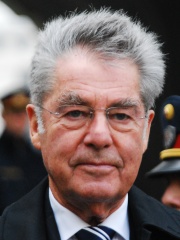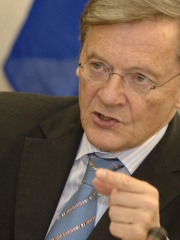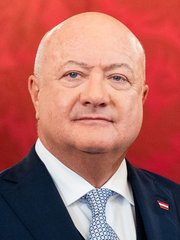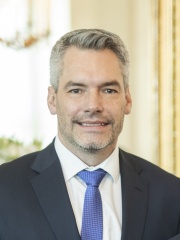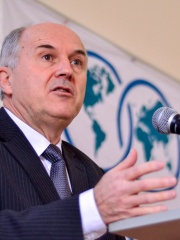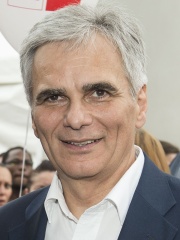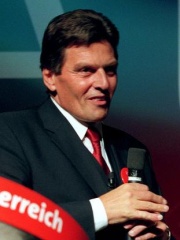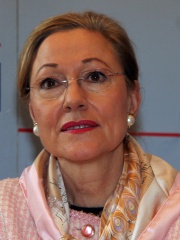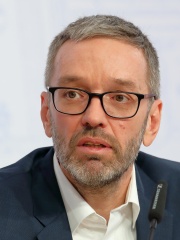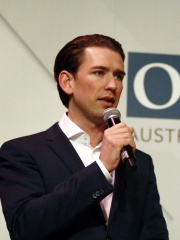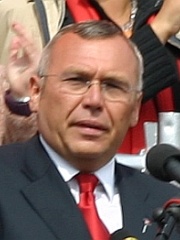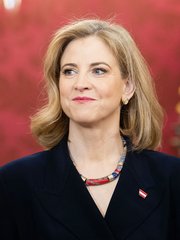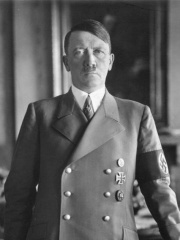

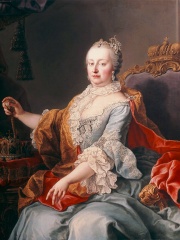
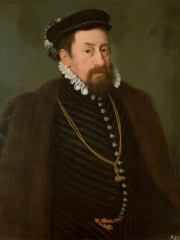
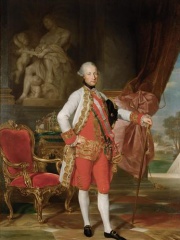
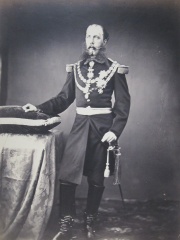
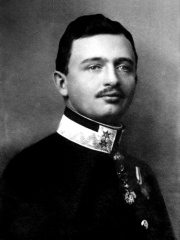
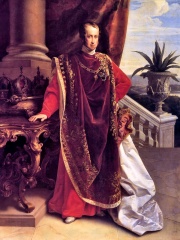
The Most Famous
POLITICIANS from Austria
This page contains a list of the greatest Austrian Politicians. The pantheon dataset contains 19,576 Politicians, 250 of which were born in Austria. This makes Austria the birth place of the 15th most number of Politicians behind Poland, and Ukraine.
Top 10
The following people are considered by Pantheon to be the top 10 most legendary Austrian Politicians of all time. This list of famous Austrian Politicians is sorted by HPI (Historical Popularity Index), a metric that aggregates information on a biography's online popularity. Visit the rankings page to view the entire list of Austrian Politicians.

1. Adolf Hitler (1889 - 1945)
With an HPI of 94.99, Adolf Hitler is the most famous Austrian Politician. His biography has been translated into 242 different languages on wikipedia.
Adolf Hitler (20 April 1889 – 30 April 1945) was an Austrian-born German politician who was the dictator of Germany during the Nazi era, which lasted from 1933 until his suicide in 1945. He rose to power as the leader of the Nazi Party, becoming the chancellor of Germany in 1933 and then taking the title of Führer und Reichskanzler in 1934. Germany's invasion of Poland on 1 September 1939 under his leadership marked the outbreak of the Second World War. Throughout the ensuing conflict, Hitler was closely involved in the direction of German military operations as well as the perpetration of the Holocaust, the genocide of about six million Jews and millions of other victims. Hitler was born in Braunau am Inn in Austria-Hungary and moved to Germany in 1913. He was decorated during his service in the German Army in the First World War, receiving the Iron Cross. In 1919, he joined the German Workers' Party (DAP), the precursor of the Nazi Party, and in 1921, was appointed the leader of the Nazi Party. In 1923, he attempted to seize governmental power in a failed coup in Munich and was sentenced to five years in prison, serving just over a year. While there, he dictated the first volume of his autobiography and political manifesto Mein Kampf (lit. 'My Struggle'). After his early release in 1924, he gained popular support by attacking the Treaty of Versailles as well as promoting pan-Germanism, antisemitism, and anti-communism with charismatic oratory and Nazi propaganda. He frequently denounced communism as being part of an international Jewish conspiracy. By November 1932, the Nazi Party held the most seats in the Reichstag, but not a majority. Former chancellor Franz von Papen and other conservative politicians convinced President Paul von Hindenburg to appoint Hitler as chancellor on 30 January 1933. Shortly thereafter on 23 March, the Reichstag passed the Enabling Act of 1933, which ultimately began the Weimar Republic's transformation into Nazi Germany. Upon Hindenburg's death on 2 August 1934, Hitler replaced him as head of state and thereafter transformed Germany into a totalitarian dictatorship. Domestically, Hitler implemented numerous racist policies and sought to deport or kill German Jews. His first six years in power resulted in rapid economic recovery from the Great Depression, the abrogation of restrictions imposed on Germany after the First World War, and the annexation of territories inhabited by millions of ethnic Germans, which initially gave him significant popular support. One of Hitler's key goals was Lebensraum (lit. 'living space') for the German people in Eastern Europe, and his aggressive, expansionist foreign policy is considered the primary cause of World War II in Europe. On 1 September 1939, Hitler oversaw the German invasion of Poland, thereby causing Britain and France to declare war on Germany. After ordering an invasion of the Soviet Union in June 1941, he declared war on the United States in December of the same year. By the end of 1941, German forces and the European Axis powers occupied most of Europe and North Africa. These gains were gradually reversed after 1941 until the Allied forces defeated the German military in 1945. On 29 April 1945, Hitler married his longtime partner, Eva Braun, in the Führerbunker in Berlin. They committed suicide the next day to avoid capture by the Soviet Red Army. The historian and biographer Ian Kershaw described Hitler as "the embodiment of modern political evil". Under Hitler's leadership and racist ideology, the Nazi regime was responsible for the genocide of an estimated six million Jews and millions of other victims, whom he and his followers deemed Untermenschen (lit. 'subhumans') or socially undesirable. Hitler and the Nazis were also responsible for the deliberate killing of an estimated 19.3 million civilians and prisoners of war. In addition, 28.7 million soldiers and civilians died as a result of military action in the European theatre. The number of civilians killed during World War II was unprecedented in warfare, and the casualties make it the deadliest conflict in history.

2. Franz Joseph I of Austria (1830 - 1916)
With an HPI of 90.65, Franz Joseph I of Austria is the 2nd most famous Austrian Politician. His biography has been translated into 84 different languages.
Franz Joseph I or Francis Joseph I (German: Franz Joseph Karl [fʁants ˈjoːzɛf ˈkaʁl]; Hungarian: Ferenc József Károly [ˈfɛrɛnt͡s ˈjoːʒɛf ˈkaːroj]; 18 August 1830 – 21 November 1916) was Emperor of Austria, King of Hungary, and the ruler of the other states of the Habsburg monarchy from 2 December 1848 until his death in 1916. In the early part of his reign, his realms and territories were referred to as the Austrian Empire, but in 1867 they were reconstituted as the dual monarchy of Austria-Hungary. From 1 May 1850 to 24 August 1866, he was also president of the German Confederation. In December 1848, Franz Joseph's uncle Emperor Ferdinand I abdicated the throne at Olomouc, as part of Minister President Felix zu Schwarzenberg's plan to end the Hungarian Revolution of 1848. Franz Joseph then acceded to the throne. In 1854, he married his first cousin Duchess Elisabeth in Bavaria, with whom he had four children: Sophie, Gisela, Rudolf, and Marie Valerie. Largely considered to be a reactionary, Franz Joseph spent his early reign resisting constitutionalism in his domains. The Austrian Empire was forced to cede its influence over Tuscany and most of its claim to Lombardy–Venetia to the Kingdom of Sardinia, following the Second Italian War of Independence in 1859 and the Third Italian War of Independence in 1866. Although Franz Joseph ceded no territory to the Kingdom of Prussia after the Austrian defeat in the Austro-Prussian War, the Peace of Prague (23 August 1866) settled the German Question in favour of Prussia, which prevented the unification of Germany from occurring under the House of Habsburg. Franz Joseph was troubled by nationalism throughout his reign. He concluded the Austro-Hungarian Compromise of 1867, which granted greater autonomy to Hungary and created the dual monarchy of Austria-Hungary. He ruled peacefully for the next 45 years, but personally suffered the tragedies of the execution of his brother Emperor Maximilian I of Mexico in 1867, the suicide of his son Rudolf in 1889, and the assassinations of his wife Elisabeth in 1898 and his nephew and heir presumptive, Archduke Franz Ferdinand, in 1914. After the Austro-Prussian War, Austria-Hungary turned its attention to the Balkans, which was a hotspot of international tension because of conflicting interests of Austria with not only the Ottoman but also the Russian Empire. The Bosnian Crisis was a result of Franz Joseph's annexation in 1908 of Bosnia and Herzegovina, which had already been occupied by his troops since the Congress of Berlin (1878). On 28 June 1914, the assassination of Archduke Franz Ferdinand in Sarajevo resulted in Austria-Hungary's declaration of war against the Kingdom of Serbia, which was an ally of the Russian Empire. This activated a system of alliances declaring war on each other, which resulted in World War I. Franz Joseph died in 1916, after ruling his domains for almost 68 years. He was succeeded by his grandnephew Charles I & IV.

3. Maria Theresa (1717 - 1780)
With an HPI of 87.44, Maria Theresa is the 3rd most famous Austrian Politician. Her biography has been translated into 91 different languages.
Maria Theresa (Maria Theresia Walburga Amalia Christina; 13 May 1717 – 29 November 1780) was the ruler of the Habsburg monarchy from 1740 until her death in 1780, and the only woman to hold the position in her own right. She was the sovereign of Austria, Hungary, Croatia, Bohemia, Transylvania, Slavonia, Mantua, Milan, Moravia, Galicia and Lodomeria, Dalmatia, Austrian Netherlands, Carinthia, Carniola, Gorizia and Gradisca, Austrian Silesia, Tyrol, Styria and Parma. By marriage, she was Duchess of Lorraine, Grand Duchess of Tuscany, and Holy Roman Empress. Maria Theresa started her 40-year reign when her father, Charles VI, Holy Roman Emperor, died on 20 October 1740. Charles VI paved the way for her accession with the Pragmatic Sanction of 1713 and spent his entire reign securing it through international diplomacy. He neglected the advice of Prince Eugene of Savoy, who believed that a strong military and a rich treasury were more important than mere signatures. Eventually, Charles VI left behind a weakened and impoverished state, particularly due to the War of the Polish Succession and the Russo-Turkish War (1735–1739). Moreover, upon his death, Saxony, Prussia, Bavaria, and France all repudiated the sanction they had recognised during his lifetime. Frederick II of Prussia (who became Maria Theresa's greatest rival for most of her reign) promptly invaded and took the affluent Habsburg province of Silesia in the eight-year conflict known as the War of the Austrian Succession. In defiance of the grave situation, she managed to secure the vital support of the Hungarians for the war effort. During the course of the war, Maria Theresa successfully defended her rule over most of the Habsburg monarchy, apart from the loss of Silesia and a few minor territories in Italy. Maria Theresa later unsuccessfully tried to recover Silesia during the Seven Years' War. Although she was expected to cede power to her husband, Emperor Francis I, and her eldest son, Emperor Joseph II, who were officially her co-rulers in Austria and Bohemia, Maria Theresa ruled as an autocratic sovereign with the counsel of her advisers. She promulgated institutional, financial, medical, and educational reforms, with the assistance of Wenzel Anton of Kaunitz-Rietberg, Friedrich Wilhelm von Haugwitz, and Gerard van Swieten. She also promoted commerce and the development of agriculture, and reorganised Austria's ramshackle military, all of which strengthened Austria's international standing. A pious Catholic, she despised Freemasons, Jews and Protestants, and on certain occasions she ordered their expulsion to remote parts of the realm. She also advocated for the Catholic Church.

4. Maximilian II, Holy Roman Emperor (1527 - 1576)
With an HPI of 83.14, Maximilian II, Holy Roman Emperor is the 4th most famous Austrian Politician. His biography has been translated into 63 different languages.
Maximilian II (31 July 1527 – 12 October 1576) was Holy Roman Emperor from 1564 until his death in 1576. A member of the Austrian House of Habsburg, he was crowned King of Bohemia in Prague on 14 May 1562 and elected King of Germany (King of the Romans) on 24 November 1562. On 8 September 1563, he was crowned King of Hungary and Croatia in the Hungarian capital Pressburg (Pozsony in Hungarian; now Bratislava, Slovakia). On 25 July 1564, he succeeded his father Ferdinand I as Holy Roman Emperor. Maximilian's rule was shaped by the confessionalization process after the 1555 Peace of Augsburg. Though a Habsburg and a Catholic, he approached the Lutheran Imperial estates with a view to overcome the denominational schism, which ultimately failed. He also was faced with the ongoing Ottoman–Habsburg wars and rising conflicts with his Spanish Habsburg cousins. According to Fichtner, Maximilian failed to achieve his three major aims: rationalizing the government structure, unifying Christianity, and evicting the Turks from Hungary. Peter Marshall opines that it is wrong to dismiss Maximilian as a failure. According to Marshall, through his religious tolerance as well as his encouragement of arts and sciences, he succeeded in maintaining a precarious peace.

5. Maximilian I, Holy Roman Emperor (1459 - 1519)
With an HPI of 82.74, Maximilian I, Holy Roman Emperor is the 5th most famous Austrian Politician. His biography has been translated into 74 different languages.
Maximilian I (22 March 1459 – 12 January 1519) was King of the Romans from 1486 and Holy Roman Emperor from 1508 until his death in 1519. He was never crowned by the Pope, as the journey to Rome was blocked by the Venetians. He proclaimed himself elected emperor in 1508 at Trent, with Pope Julius II later recognizing it. This broke the tradition of requiring a papal coronation for the adoption of the Imperial title. Maximilian was the only surviving son of Frederick III, Holy Roman Emperor, and Eleanor of Portugal. From his coronation as King of the Romans in 1486, he ran a double government, or Doppelregierung with his father until Frederick's death in 1493. Maximilian expanded the influence of the House of Habsburg through war and his marriage in 1477 to Mary, Duchess of Burgundy. However, he also lost his family's lands in Switzerland to the Swiss Confederacy. Through the marriage of his son Philip the Handsome to eventual queen Joanna of Castile in 1496, Maximilian helped to establish the Habsburg dynasty in Spain, which allowed his grandson Charles to hold the thrones of both Castile and Aragon. Historian Thomas A. Brady Jr. describes him as "the first Holy Roman Emperor in 250 years who ruled as well as reigned" and the "ablest royal warlord of his generation". Nicknamed "Coeur d'acier" ("Heart of steel") by Olivier de la Marche and later historians (either as praise for his courage and soldierly qualities or reproach for his ruthlessness as a warlike ruler), Maximilian has entered the public consciousness, at least in the German-speaking world, as "the last knight" (der letzte Ritter), especially since the eponymous poem by Anastasius Grün was published (although the nickname likely existed even in Maximilian's lifetime). Scholarly debates still discuss whether he was truly the last knight (either as an idealized medieval ruler leading people on horseback, or a Don Quixote-type dreamer and misadventurer), or the first Renaissance prince—an amoral Machiavellian politician who carried his family "to the European pinnacle of dynastic power" largely on the back of loans. Historians of the late nineteenth century like Leopold von Ranke often criticized Maximilian for putting the interest of his dynasty above that of Germany, hampering the nation's unification process. Since Hermann Wiesflecker's Kaiser Maximilian I. Das Reich, Österreich und Europa an der Wende zur Neuzeit (1971–1986) became the standard work, a more positive image of the emperor has emerged. He is seen as a modern, innovative ruler who carried out important reforms and promoted significant cultural achievements, even if the financial costs weighed down the Austrians and his military expansion and caused the deaths and sufferings of many people. Through an "unprecedented" image-building program, with the help of many notable scholars and artists, in his lifetime, the emperor—"the promoter, coordinator, and prime mover, an artistic impresario and entrepreneur with seemingly limitless energy and enthusiasm and an unfailing eye for detail"—had built for himself "a virtual royal self" of a quality that historians call "unmatched" or "hitherto unimagined". To this image, new layers have been added by the works of later artists in the centuries following his death, both as continuation of deliberately crafted images developed by his program as well as development of spontaneous sources and exploration of actual historical events, creating what Elaine Tennant dubs the "Maximilian industry".

6. Joseph II, Holy Roman Emperor (1741 - 1790)
With an HPI of 82.18, Joseph II, Holy Roman Emperor is the 6th most famous Austrian Politician. His biography has been translated into 72 different languages.
Joseph II (13 March 1741 – 20 February 1790) was Holy Roman Emperor from 18 August 1765 and sole ruler of the Habsburg monarchy from 29 November 1780 until his death. He was the eldest son of Empress Maria Theresa and her husband, Emperor Francis I, and the brother of Marie Antoinette, Leopold II, Maria Carolina of Austria, and Maria Amalia, Duchess of Parma. He was thus the first ruler in the Austrian dominions of the union of the Houses of Habsburg and Lorraine, styled Habsburg-Lorraine. Joseph was a proponent of enlightened absolutism like his brother Leopold II; however, his commitment to secularizing, liberalizing and modernizing reforms resulted in significant opposition, which resulted in failure to fully implement his programs. Meanwhile, despite making some territorial gains, his reckless foreign policy badly isolated Austria. He has been ranked with Catherine the Great of Russia and Frederick the Great of Prussia as one of the three great Enlightenment monarchs. False but influential letters depict him as a somewhat more radical philosophe than he probably was. His policies are now known as Josephinism. He was a supporter of the arts, particularly of composers such as Wolfgang Amadeus Mozart and Antonio Salieri. He died with no known surviving legitimate offspring and was succeeded by his younger brother Leopold II.

7. Maximilian I of Mexico (1832 - 1867)
With an HPI of 82.14, Maximilian I of Mexico is the 7th most famous Austrian Politician. His biography has been translated into 59 different languages.
Maximilian I (Spanish: Fernando Maximiliano José María de Habsburgo-Lorena; German: Ferdinand Maximilian Josef Maria von Habsburg-Lothringen; 6 July 1832 – 19 June 1867) was an Austrian archduke who became emperor of the Second Mexican Empire from 10 April 1864 until his execution by the Mexican Republic on 19 June 1867. A member of the House of Habsburg-Lorraine, Maximilian was the younger brother of Emperor Franz Joseph I of Austria. Before becoming Emperor of Mexico, he was commander-in-chief of the small Imperial Austrian Navy and briefly the Austrian viceroy of Lombardy–Venetia, but was removed by the emperor. Two years before his dismissal, he briefly met with French emperor Napoleon III in Paris, where he was approached by conservative Mexican monarchists seeking a European royal to rule Mexico. Initially Maximilian was not interested, but following his dismissal as viceroy, the Mexican monarchists' plan was far more appealing to him. Since Maximilian was a descendant of Charles V, Holy Roman Emperor, King of Spain when the Spaniards conquered the Aztecs (1519–21) and first brought Mexico into the Spanish Empire, a status it held until the Mexican independence in 1821, Maximilian seemed a perfect candidate for the conservatives' plans for monarchy in Mexico. Maximilian was interested in assuming the throne, but only with guarantees of French support. Mexican conservatives did not take sufficient account of Maximilian's embrace of liberalism, and Maximilian failed to understand he would be viewed as a foreign outsider. When Maximilian was first mentioned as a possible emperor of Mexico, the idea seemed farfetched, but circumstances changed and made it viable. His tenure as emperor was just three years, ending with his execution by firing squad by forces of the Restored Republic on 19 June 1867. Political conflicts in Mexico in the 1850s between conservative and liberal factions were domestic disputes initially, but the conservatives' loss on the battlefield to the liberal regime during a three-year civil war (1858–61) meant conservatives sought ways to return to power with outside allies, opening a path for France under Napoleon III to intervene in Mexico and set up a puppet regime with conservative Mexican support. When the liberal government of Mexican President Benito Juárez suspended payment on foreign debts in 1861, there was an opening for European powers to intervene militarily in Mexico. The intention of the French and Mexican conservatives was for regime change to oust the liberals, backed by the power of the French army. Mexican monarchists sought a European head of state and, with the brokering of Napoleon III, Maximilian was invited to establish what would come to be known as the Second Mexican Empire. With a pledge of French military support and at the formal invitation of a Mexican delegation, Maximilian accepted the crown of Mexico on 10 April 1864 following a bogus referendum in Mexico that purportedly showed the Mexican people backed him. Maximilian's hold on power in Mexico was shaky from the beginning. Rather than enacting policies that would return power to Mexican conservatives, Maximilian instead sought to implement liberal policies, losing him his domestic conservative backers. Internationally, his legitimacy as ruler was in doubt since the United States continued to recognize Benito Juárez as the legal head of state rather than Emperor Maximilian. The U.S. saw the French invasion as a violation of the Monroe Doctrine, but the U.S. was unable to intervene politically due to the American Civil War (1861–1865). With the end of the American Civil War in 1865, the United States began providing material aid to Juárez's republican forces. In the face of a renewed U.S. interest in enforcing the Monroe Doctrine, under orders by Napoleon III, the French armies that had propped up Maximilian's regime began withdrawing from Mexico in 1866. With no popular support and republican forces in the ascendant, Maximilian's monarchy collapsed. Maximilian was captured in Querétaro. He was tried and executed by the restored Republican government alongside his generals Miguel Miramón, a former president of Mexico, and Tomás Mejía Camacho in June 1867. His death marked the end of monarchism as a major force in Mexico. In reassessments of his brief rule, he is portrayed in Mexican history less as the villain of nationalist, republican history and more as a liberal in Mexico, along with Presidents of the Republic Juárez, Sebastián Lerdo de Tejada, and Porfirio Díaz.

8. Charles I of Austria (1887 - 1922)
With an HPI of 81.72, Charles I of Austria is the 8th most famous Austrian Politician. His biography has been translated into 65 different languages.
Charles I and IV (German: Karl Franz Josef Ludwig Hubert Georg Otto Maria, Hungarian: Károly Ferenc József Lajos Hubert György Ottó Mária; 17 August 1887 – 1 April 1922) was Emperor of Austria (as Charles I), King of Hungary (as Charles IV), and the ruler of the other states of the Habsburg monarchy from November 1916 until the monarchy was abolished in November 1918. He was the last of the monarchs belonging to the House of Habsburg-Lorraine to rule over Austria-Hungary. The son of Archduke Otto of Austria and Princess Maria Josepha of Saxony, Charles became heir presumptive of Emperor Franz Joseph when his uncle Archduke Franz Ferdinand of Austria was assassinated in 1914. In 1911, he married Princess Zita of Bourbon-Parma. Charles succeeded to the thrones in November 1916 following the death of his grand-uncle, Franz Joseph. He began secret negotiations with the Allies, hoping to peacefully end the First World War, but was unsuccessful. Despite Charles's efforts to preserve the empire by returning it to federalism and by championing Austro-Slavism, Austria-Hungary hurtled into disintegration: Czechoslovakia and the State of Slovenes, Croats and Serbs were proclaimed, and Hungary broke monarchic ties to Austria by the end of October 1918. Following the Armistice of 11 November 1918, Charles "renounced any participation" in government affairs, but did not abdicate. However, the Republic of German-Austria was proclaimed the following day, and in April 1919 the National Assembly formally dethroned the Habsburgs and banished Charles from German-Austria for life. Charles spent the early part of his exile in Switzerland. He spent the remaining years of his life attempting to restore the monarchy. He made two attempts to reclaim the Hungarian throne in 1921, but failed due to the opposition of Hungary's Calvinist regent, Admiral Miklós Horthy. Charles was exiled for a second time to the Portuguese island of Madeira, where he soon fell ill and died of respiratory failure in 1922. A deeply religious man, Charles was beatified by the Catholic Church in 2004, with October 21 as his feast day.

9. Ferdinand I of Austria (1793 - 1875)
With an HPI of 81.62, Ferdinand I of Austria is the 9th most famous Austrian Politician. His biography has been translated into 63 different languages.
Ferdinand I (German: Ferdinand I. 19 April 1793 – 29 June 1875) was Emperor of Austria from March 1835 until his abdication in December 1848. He was also King of Hungary, Croatia and Bohemia (as Ferdinand V), King of Lombardy–Venetia and holder of other lesser titles (see grand title of the Emperor of Austria). Due to his passive but well-intentioned character, he gained the sobriquet The Benign (German: Der Gütige) or The Benevolent (Czech: Ferdinand Dobrotivý, Polish: Ferdynand Dobrotliwy). Ferdinand succeeded his father Francis I upon his death on 2 March 1835. He was incapable of ruling the empire because of severe epilepsy, so his father, before he died, made a will promulgating that Ferdinand should consult his uncle Archduke Louis on all aspects of internal policy and urged him to be influenced by Prince Metternich, Austria's Foreign Minister. Following the Revolutions of 1848, Ferdinand abdicated on 2 December 1848. He was succeeded by his nephew, Franz Joseph. Following his abdication, he lived in Hradčany Palace, Prague, until his death in 1875. Ferdinand married Maria Anna of Savoy, the sixth child of Victor Emmanuel I of Sardinia. They had no children.
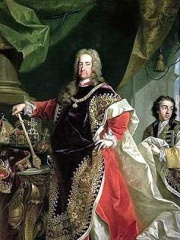
10. Charles VI, Holy Roman Emperor (1685 - 1740)
With an HPI of 81.13, Charles VI, Holy Roman Emperor is the 10th most famous Austrian Politician. His biography has been translated into 72 different languages.
Charles VI (German: Karl; Latin: Carolus; 1 October 1685 – 20 October 1740) was Holy Roman Emperor and ruler of the Austrian Habsburg monarchy from 1711 until his death, succeeding his elder brother, Joseph I. He unsuccessfully claimed the throne of Spain following the death of his relative, Charles II. In 1708, he married Elisabeth Christine of Brunswick-Wolfenbüttel, by whom he had his four children: Leopold Johann (who died in infancy), Maria Theresa, Maria Anna (Governess of the Austrian Netherlands), and Maria Amalia (who also died in infancy). Four years before the birth of Maria Theresa, faced with his lack of male heirs, Charles provided for a male-line succession failure with the Pragmatic Sanction of 1713. The Emperor favoured his own daughters over those of his elder brother and predecessor, Joseph I, in the succession, ignoring the Mutual Pact of Succession he had signed during the reign of his father, Leopold I. Charles sought the other European powers' approval. They demanded significant terms, among which were that Austria close the Ostend Company. In total, the states of Great Britain, France, Saxony-Poland, the Dutch Republic, Spain, Venice, the Papal States, Prussia, Russia, Denmark, Savoy-Sardinia, and Bavaria, plus the Diet of the Holy Roman Empire, recognised the sanction. France, Spain, Saxony-Poland, Bavaria, and Prussia later reneged. Charles died in 1740, sparking the War of the Austrian Succession, which plagued his successor, Maria Theresa, for eight years.
People
Pantheon has 250 people classified as Austrian politicians born between 454 and 1995. Of these 250, 50 (20.00%) of them are still alive today. The most famous living Austrian politicians include Heinz Fischer, Wolfgang Schüssel, and Christian Stocker. The most famous deceased Austrian politicians include Adolf Hitler, Franz Joseph I of Austria, and Maria Theresa. As of April 2024, 10 new Austrian politicians have been added to Pantheon including Christian Stocker, Michael Ludwig, and Elke Kahr.
Living Austrian Politicians
Go to all RankingsHeinz Fischer
1938 - Present
HPI: 72.88
Wolfgang Schüssel
1945 - Present
HPI: 64.95
Christian Stocker
1960 - Present
HPI: 64.25
Franz Vranitzky
1937 - Present
HPI: 64.01
Karl Nehammer
1972 - Present
HPI: 63.08
Valentin Inzko
1949 - Present
HPI: 61.91
Werner Faymann
1960 - Present
HPI: 61.08
Viktor Klima
1947 - Present
HPI: 61.07
Benita Ferrero-Waldner
1948 - Present
HPI: 58.78
Herbert Kickl
1968 - Present
HPI: 58.66
Sebastian Kurz
1986 - Present
HPI: 58.05
Alfred Gusenbauer
1960 - Present
HPI: 57.16
Deceased Austrian Politicians
Go to all RankingsAdolf Hitler
1889 - 1945
HPI: 94.99
Franz Joseph I of Austria
1830 - 1916
HPI: 90.65
Maria Theresa
1717 - 1780
HPI: 87.44
Maximilian II, Holy Roman Emperor
1527 - 1576
HPI: 83.14
Maximilian I, Holy Roman Emperor
1459 - 1519
HPI: 82.74
Joseph II, Holy Roman Emperor
1741 - 1790
HPI: 82.18
Maximilian I of Mexico
1832 - 1867
HPI: 82.14
Charles I of Austria
1887 - 1922
HPI: 81.72
Ferdinand I of Austria
1793 - 1875
HPI: 81.62
Charles VI, Holy Roman Emperor
1685 - 1740
HPI: 81.13
Theodoric the Great
454 - 526
HPI: 81.06
Rudolf II, Holy Roman Emperor
1552 - 1612
HPI: 80.50
Newly Added Austrian Politicians (2025)
Go to all RankingsChristian Stocker
1960 - Present
HPI: 64.25
Michael Ludwig
1961 - Present
HPI: 52.13
Elke Kahr
1961 - Present
HPI: 51.74
Beate Meinl-Reisinger
1978 - Present
HPI: 46.98
Klaudia Tanner
1970 - Present
HPI: 45.48
Leonore Gewessler
1977 - Present
HPI: 42.82
Marion Kreiner
1981 - Present
HPI: 38.54
Thomas Koch
1983 - Present
HPI: 35.64
Philipp Eng
1990 - Present
HPI: 34.70
Vanessa Herzog
1995 - Present
HPI: 33.04
Overlapping Lives
Which Politicians were alive at the same time? This visualization shows the lifespans of the 25 most globally memorable Politicians since 1700.

